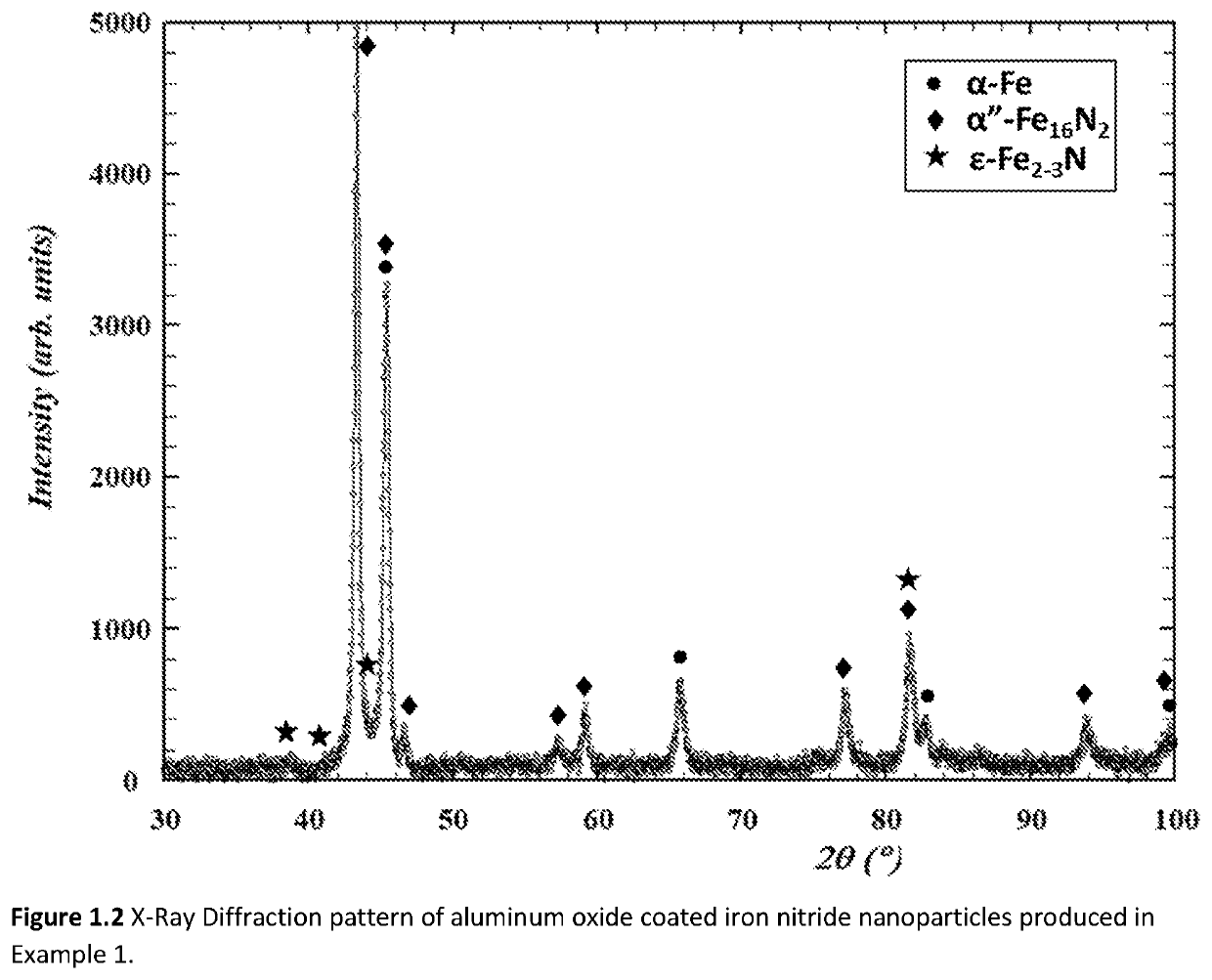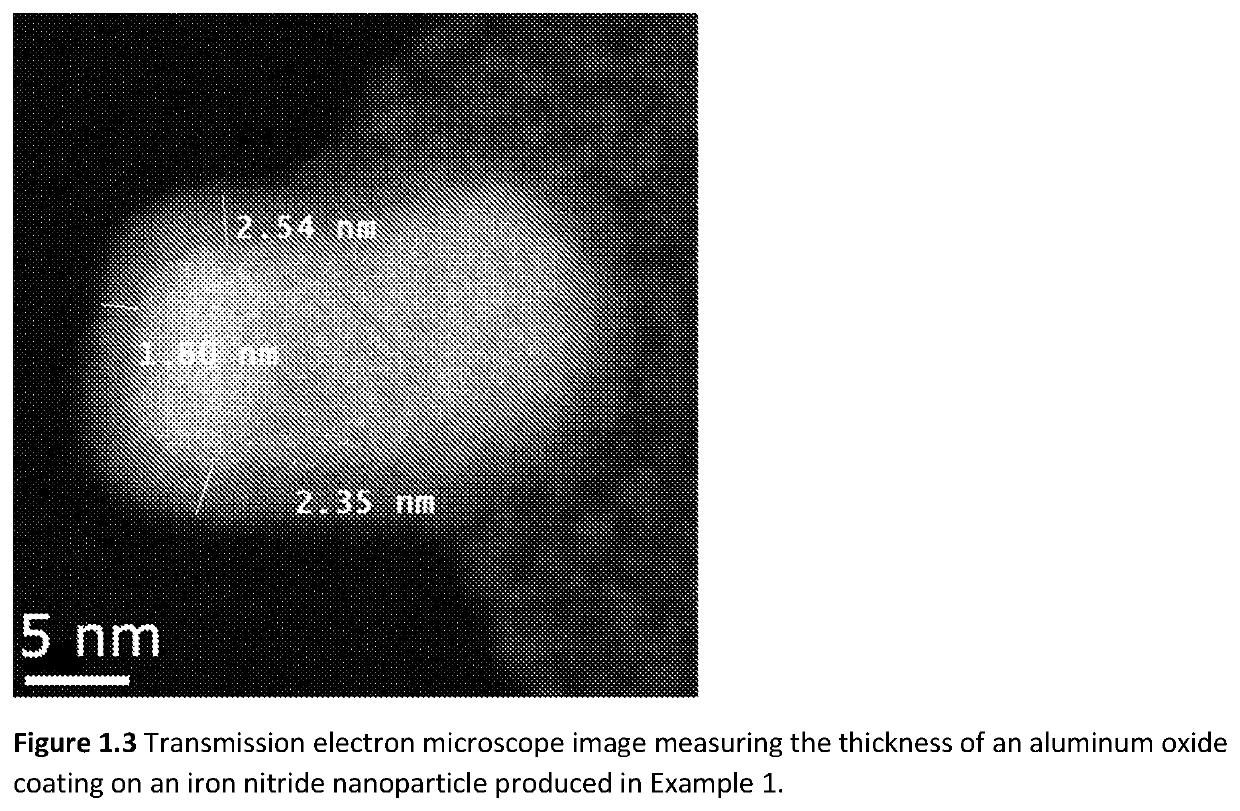Coercivity-enhanced iron nitride nanoparticles with high saturation magnetization
a technology of coercivity and iron nitride, which is applied in the direction of magnetic materials, solid-state diffusion coatings, magnetic bodies, etc., can solve the problems of large dilution of the overall saturation magnetization of the core/shell nanoparticle, limited the performance of permanent magnets manufactured from iron nitride nanoparticles, and difficult control
- Summary
- Abstract
- Description
- Claims
- Application Information
AI Technical Summary
Benefits of technology
Problems solved by technology
Method used
Image
Examples
example 1
[0100]The starting materials for Example 1 were iron nitride nanoparticles prepared by reduction and nitriding of commercially procured γ-Fe2O3 nanoparticles in a 2″ diameter rotary tube furnace. A total of 9 lots of nanoparticles, each lot approximately 1.2 grams in mass, were combined together to make the starting materials for the aluminum oxide coating operation. The γ-Fe2O3 nanoparticles were first transformed into α-Fe nanoparticles by reduction in H2 gas flowing at 200 sccm (standard cubic centimeters per minute) at 335° C. for 12 hours. The α-Fe nanoparticles were subsequently transformed into iron nitride nanoparticles by flowing NH3 gas at a rate of 60 sccm at 135° C. for 22 hours. The iron nitride nanoparticles were both unloaded and stored in a nitrogen filled glovebox. Phase analysis by X-Ray diffraction indicated that the iron nitride nanoparticles were a mixture of α″-Fe16N2, α-Fe2-3N, and α-Fe. The majority of the phase fraction was α″-Fe16N2.
[0101]The aluminum oxide...
example 2
[0105]The starting materials for Example 2 were nine lots of iron nitride nanoparticles, each lot approximately 1.2 grams in mass, that were prepared in a rotary tube furnace by the same method described in Example 1. The atomic layer deposition parameters in Example 2 were also the same as Example 1, except for the fluidized bed temperature. The fluidized bed temperature in Example 2 was set to be 130° C. The hysteresis loop measured on the coated nanoparticles (FIG. 2.1) shows a saturation magnetization of 181 emu / gram and an intrinsic coercivity of 1,916 Oe. The X-Ray diffraction pattern again shows a mixture (FIG. 2.2) of α″-Fe16N2, α-Fe2-3N, and α-Fe phases. The major X-Ray diffraction peaks of each phase present in Example 2 are identified below in Table 2. Mossbauer spectroscopy indicates that the mass fraction of the α-Fe16N2 phase is 67%. The thickness of the aluminum oxide was measured to be 2.0-4.0 nm by high resolution transmission electron microscopy (FIG. 2.3 and FIG. ...
example 3
[0107]The starting materials for Example 3 were commercially procured γ-Fe2O3 nanoparticles. Prior to being loaded into the fluidized bed reaction vessel, the γ-Fe2O3 nanoparticles were sieved and the 25 μm to 53 μm sieve fraction was retained. After loading into the fluidized bed reactor, the γ-Fe2O3 nanoparticles were transformed into α-Fe nanoparticles by reducing in H2 gas flowing at 200 sccm at 315° C. for 15 hours. The α-Fe nanoparticles were then transformed into iron nitride nanoparticles by NH3 gas flowing at 120 sccm at 135° C. for 40 hours. A coating of aluminum oxide was applied on the surface of the iron nitride nanoparticles by atomic layer deposition using 9 cycles of alternating trimethylaluminum and water at 100° C.
[0108]The hysteresis loop on the coated nanoparticles (FIG. 3.2) shows a saturation magnetization of 158 emu / gram and an intrinsic coercivity of 1,798 Oe. The X-Ray diffraction pattern (FIG. 3.2) shows a mixture of the desired of α″-Fe16N2, α-Fe2-3N, and ...
PUM
| Property | Measurement | Unit |
|---|---|---|
| coercivity | aaaaa | aaaaa |
| thickness | aaaaa | aaaaa |
| stability temperature | aaaaa | aaaaa |
Abstract
Description
Claims
Application Information
 Login to View More
Login to View More - R&D
- Intellectual Property
- Life Sciences
- Materials
- Tech Scout
- Unparalleled Data Quality
- Higher Quality Content
- 60% Fewer Hallucinations
Browse by: Latest US Patents, China's latest patents, Technical Efficacy Thesaurus, Application Domain, Technology Topic, Popular Technical Reports.
© 2025 PatSnap. All rights reserved.Legal|Privacy policy|Modern Slavery Act Transparency Statement|Sitemap|About US| Contact US: help@patsnap.com



